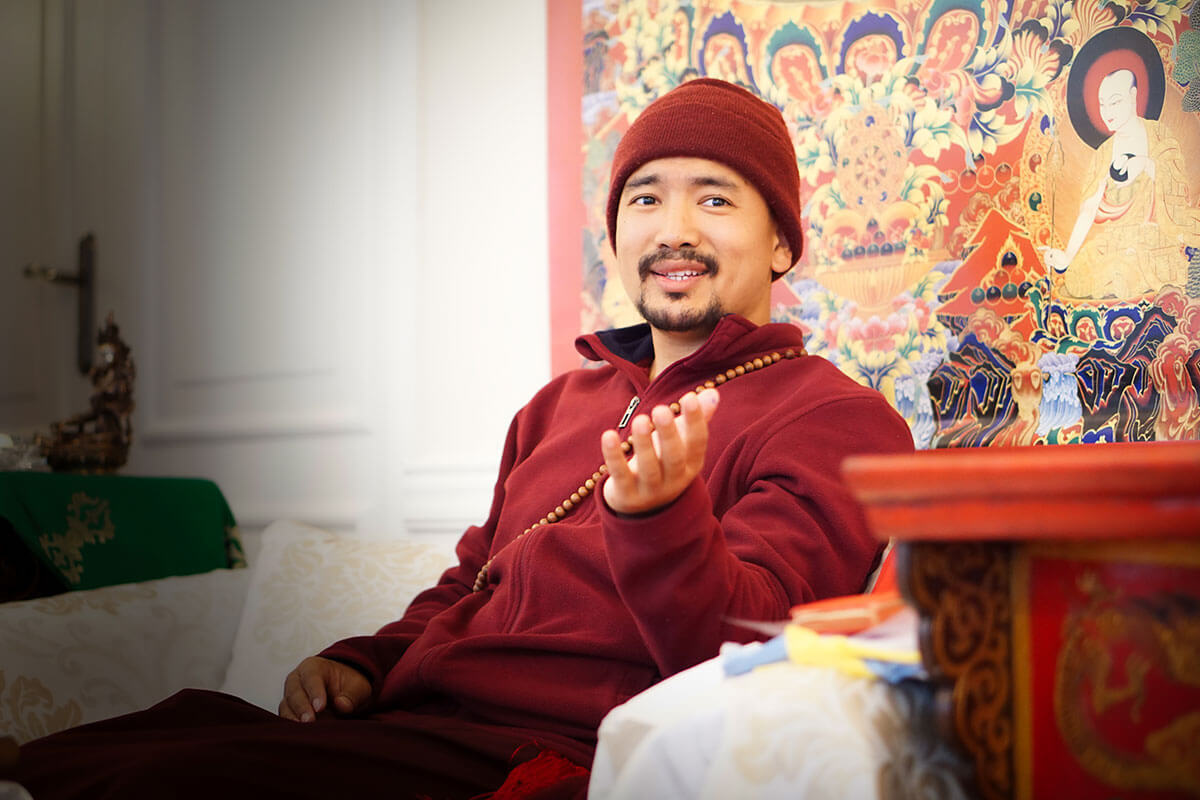How to choose the right practice?
This is a very good question for someone who wants to practice seriously, it is the most important question one should ask oneself as a practitioner. Before choosing a practice method, it is important to find out what exactly practice is. Once you understand what practice means, then finding a training method is easy. Then you will naturally understand which method is right for you.
What is practice for?
For me, practice means to modify, to improve. How to heal ourselves. Practice can be understood as: training the mind or training behaviour. Train the mind by training the behaviour or train the behaviour by training the mind. Many people think: “I want to start practising “ or they say: “I am practising every day”. However, many people do not know what they should be practising, nor do they know what they are practising.
Just as a patient who needs treatment must first find out what his illness is and then know which doctor to go to and what treatment to use; if you want to practise, you must first clearly analyse what psychology or behaviour of yours needs to be changed.
The mind of a samsaric being contains five poisons: greed, anger, ignorance, pride and jealousy or doubt. These bring a series of worries and sufferings that must be cut through practice. The degree of greed, anger, ignorance, pride and doubt or jealousy is not the same for everyone. Some people have a deeper degree of greed and others have a deeper degree of anger. Therefore, you must first analyse which one generates more trouble and suffering for you.
Taking myself as an example, every day for more than 10 years, I used to attend morning and evening meditation sessions at the monastery. I was also studying Buddhist philosophy at the Shedra-Buddhist Academy; but at that time I also did not realise clearly what I was practising.
Once, I was meditating alone at the Shedra-Buddhist Academy and during meditation, my Yidam Manjushri instructed me that I should first detect and analyse my own shortcomings, then focus my practice on working with them. At that time, the degree of pride in my mind was relatively deep. At that time, I felt that I was a great incarnation, like a living Buddha, and my achievements and teaching performance were relatively good. Therefore, I thought I was very powerful and could not put my feet on the ground. I was so arrogant that I could not see the earth, but only the sky. Until suddenly, I realised that although I had been practising for a long time, I did not know what I had been practising; so I analysed and found this deficiency of mine, then I focused the practice on improving this.
Which method to choose?
Buddhism has 84,000 methods, all of which are used to train the mind of sentient beings. In Buddhism there are Hinayana, Mahayana and Vajrayana methods. Some people practice compassion all their lives and become liberated; others meditate all their lives and become liberated; others gain their wisdom by studying Buddhism all their lives and become liberated.
Which practice is right for you?
If you have enough wisdom, you can explore for yourself and analyse whether the method is right for you by your own feelings and sixth sense; if you need guidance, you can find a teacher to help you explore. A teacher who understands you will guide you properly to choose a practice that suits you. Of course, different teachers have different methods.
It is difficult to break a bunch of matches at once, but it will be much easier if you break them one by one. Similarly, there are many defects in each person; you can’t expect to change them all at once. Let’s say it’s as if you have several places in your body that need to be operated on. However, due to time constraints you can only do one surgery at a time. So the worst will be operated on first and then the problem will be solved step by step.
I have previously discussed some methods to eliminate greed. To eliminate the habit of arrogance I recommend the method of chanting the mantra of Manjushri. Visualise the universe, where the earth becomes a far away point and one’s own body ceases to exist, so that one reaches the state of no-self. Then one slowly returns to the earth and one’s own body. Through this practice, the person becomes humble and realises that there is no reason to be arrogant. As a result, arrogance will naturally decrease more and more.
In short, before training the mind or training the behaviour, one must first write down all the faults. Everyone has faults, some to a greater or lesser degree. So find the most important defects that you need to lessen and determine a goal to work with them in practice.
Secondly, the method of practice can be found by studying the Dharma for yourself. It can also be by finding your teacher and letting him or her guide you, step by step, according to your specific situation. A combination of both circumstances is possible.
Thirdly, the most important thing is to analyse the effect of the practice on you. That is, to analyse whether the current method of practice is appropriate for you. If you find it effective, it means that it is right for you. If you find that there are no results, it means that you need to change the method you have been practising.
If emptiness is practised without compassion
During the last few years, some European students of Tibetan Buddhism have asked me for instructions on how to practice emptiness (Śūnyatā). At the last retreat in Europe, I emphasised that personally, I don’t think it is so difficult to attain emptiness. I can help you to have the experience in a very short period of time. However, for lay practitioners, if they lack compassion and get the experience of attaining emptiness too soon, then there is a great danger.
I believe that lay practitioners should not be too anxious to attain the experience of emptiness. Generally, they should work on accumulating merit, purifying bad karma and improving their knowledge of Buddhism. Then, on the basis of establishing the correct Buddhist view, one practises compassion and emptiness at the same time, so that the practice will be headed in the right direction.
Emptiness without compassion is very dangerous
There are three types of experiences of emptiness:
- One is the theoretical experience when you have studied the theory of emptiness to a certain level.
- The second is when you use your own thinking and imagination, then you think you have the experience of emptiness. Both experiences are false and illusory.
- The third is the true experience of emptiness.
When I was in the Buddhist Institute I used to meditate for several days at a time. I had a theoretical and intellectual experience of emptiness and some real experience of emptiness. For a few months I felt that the whole world was an emptiness and that nothing made sense, I didn’t want to live. I felt especially tired because I had been playing a role in this fake world, in this fake emptiness. After a few months like this, I felt empty and dark. Then little by little I became disinterested in the things I used to like, eating, sleeping, having fun, etc. All my interests gradually disappeared. I didn’t want to meditate or read the Buddhist texts because I felt that everything was unreal.
Later I realised that the reason I was in this state was because of a lack of compassion. If you practice without compassion and just try to grasp emptiness, it is very dangerous, especially for lay practitioners. If you don’t have enough loving-kindness, not enough compassion, not enough merit, not enough purification and you practice emptiness on that basis; you experience theoretical or illusory emptiness. When you enter such a state without the guidance of a teacher by your side, you will really feel that there is no world anymore and that there is no more birth or death. Gradually you will become disbelieving of cause and effect and will think that all beings are illusions. Then you will begin to feel nothing for your family, your loved ones, your children, and even less for your friends, work and money. So everyday interests such as watching movies, meeting friends, having fun, etc. will gradually disappear.
Have you ever driven a car? When you drive, both the accelerator and the brake are important. Do you think it would be dangerous if there were no brakes, only an accelerator? The practice of emptiness is like the accelerator and compassion is like the brake. The balance between the two is important. If there is only emptiness without compassion, then you don’t know where you are going; you just go on and on without knowing where you will end up.
Compassion is the key to emptiness
Many great masters used to tell lay practitioners that they should be good people, accumulate merit and purify bad karma. Accumulating merit in this case means doing good deeds, going on pilgrimages, freeing animals, being kind and compassionate to all sentient beings. To purify bad karma means not to do bad deeds and to gradually control and reduce bad habits.
Why did those masters want to waste the time of lay practitioners? Why did they make lay practitioners go on accumulating merit, doing good deeds for decades? Why didn’t they just tell them the truth of emptiness? After they had the experience, why didn’t they let them enter the state of emptiness so that the path of liberation would be clear? In my view at that time, there was no need to go on accumulating merit throughout life. I thought that practitioners, by entering directly into the actual experience of emptiness, would already be purified and accumulating merit.
Now I believe that these teachers did not waste the practitioner’s time. Loving-kindness, compassion, accumulation of merit and purification of bad karma are really important. The Buddha also talked about not preaching emptiness to people who are not really worthy of this teaching. This is also one of the precepts of tantric teaching. If there is no compassion, it is useless to attain emptiness. This is the equivalent of a very rich person giving you his bank card. What would happen if you suddenly found out that all his money was in it? Would you be happy? Surely you would, but what if you later discovered that the card had a password on it that he didn’t give it to you? A bank card without a password is a useless piece of plastic. Emptiness without compassion is exactly the same as a bank card without a password. If you have attained the experience of emptiness without compassion for sentient beings, then emptiness will have no meaning for you.
Why is compassion so important?
For example, why is your body on the ground, why don’t you sink to the ground, or fly in the sky, or disappear in the air like water vapour?
Because two very important elements are involved: One is gravity which stabilises your body. The other is consciousness, which is a big space, like a vacuum. If there was no consciousness; if there was only the body, one could imagine that the body would be like a stone, without soul and without feeling. If there was only consciousness without a body, we would be like the wind, flying all the time, unstable; or like water vapour, unable to find a fixed place, slowly disappearing. The combination of body and consciousness together produces such a structure: one element is to help stabilise us, and the other is to give us space. Compassion is equivalent to how gravity acts in relation to our body. All sentient beings act towards each other like the example of gravity and the body, helping to stabilise each other in this life.
Practitioners need compassion, as a method of practice, to achieve liberation and enlightenment. A practitioner without compassion can only go to the realm of form or the formless realm, or to a completely empty place. If the foundation of compassion is not stable, the experience of emptiness that has been achieved is not the ultimate liberation. Only the combination of emptiness and compassion is the ultimate enlightenment.
The highest compassion is bodhicitta
There are also many levels of compassion. If you are a lay practitioner, you may already have your own children, a spouse and parents to care for. Caring for someone requires the power of love, which is also compassion and is a good foundation. But if you put all your attention only on a very small area, then your compassion will be very small and your capacity will be wasted.
As a buddhist lay practitioner, you must gradually widen the scope of compassion. While you are responsible for your parents, children, spouse, company, clients, etc., you must open your heart to all sentient beings. You must help and care for all sentient beings as you do for your family. If you feel compassion when your own child cries, and you feel upset when someone else’s child cries; this is not right. You have to treat all children as well as your own.
The highest level of compassion is bodhicitta. The characteristic of bodhicitta is to develop bodhicitta for the sake of all sentient beings and to become a Buddha for the sake of all sentient beings. Many students have asked me:
Why do Mahāyāna Buddhists carry the problems of all sentient beings? I am interested in liberation and enlightenment, not sentient beings.
It is very important to understand why we need to know how to develop bodhicitta. Compassion for all sentient beings is actually a power to attain enlightenment. Just like a mother for whom her children are her strength and she would give everything to take care of them. Some people are willing to contribute for the good of society, of the company, and that also becomes a power. All sentient beings are the force for you to become a Buddha, not a burden, not an obstacle. Just like when you put some wood and oil into a small flame, the flame will become bigger.
Mahayana Buddhism emphasises the practice of compassion. Reaching liberation in this way is quicker and safer. Some teachings say that it takes an especially long time to become a Buddha. Mahayana Buddhism emphasises that the practice of compassion shortens the process and will be even shorter, if tantric methods are added.
Build a good foundation of compassion now. When your practice reaches a certain level, you will not want to leave sentient beings. Even if the whole world is in chaos, your compassion for sentient beings will not change. On this basis, I guarantee you will attain emptiness.
Maintaining awareness of the Buddha nature
In Tantra, the Buddha nature can be shown to all sentient beings so that everyone can discover the truth about themselves. Buddha-nature is emptiness, emptiness is Buddha-nature. However, it is important to emphasise the characteristic of Buddha nature that is expressed through the non-duality of clarity and emptiness. When practising emptiness, one cannot go in the direction of nothingness, this will be dangerous.
I will now share a very important trick that you must remember. Its application can serve as a protection and help you in your practice so that you never enter into an experience of theoretical or illusory emptiness, nor into the meditative state of the form realms or the formless realms.
The trick is to always remain mindful of Buddha-nature while practising. When practising Shine (Samatha) and Lhaktong (Vipassana), you will sometimes enter a very calm place, as if entering the deepest part of the ocean. If you have ever dived, you will probably have had the experience that when you get to 10, 15, 20 metres, the whole world goes silent. You may feel very scared because there seems to be no way back. In practice, when you have reached a very deep state it feels as if you have entered the void and everything is gone, even the person who is meditating is gone. There is a bit of danger in this situation, you can’t just disappear. You have to have awareness and maintain the state of awareness of being a Buddha. At this moment, it is not about using visualisation or using thoughts to say “I am the Dharmakaya, I am Buddha” it is about maintaining a natural, pure, inner, undiluted state. This natural state is our original mind, which is the Buddha, the Dharmakaya, the Buddha nature.
If you maintain the confidence that “I am Buddha”, the theoretical, illusory experiences of emptiness will naturally transfer to the actual experience of emptiness. This is the most important trick.
May all of you reading this article soon find the right practice for each of you, and may this enable you to attain liberation for the benefit of all sentient beings!



